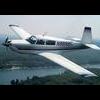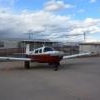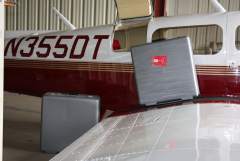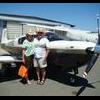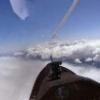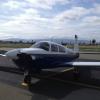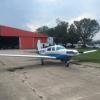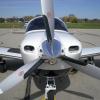Leaderboard
Popular Content
Showing content with the highest reputation on 12/10/2012 in all areas
-
mpls623995, I believe it's completly inappropriate for an instructor to fly an approach with the weather at "RVR 1080, less than 1/4 mile, and ceilings at 100 or lower" in a C172 with a student and passengers. Legal, sure; stupid, absolutely. (I've have 50 years flying, with 40 in jets, and have flown my share of approaches to 600 RVR--in air transports.)2 points
-
From the album: Misc
They are not going in the baggage door. However, they will fit through the front door and, with a seat removed, slide into the baggage compartment.© Carl Stevens
1 point -
Hank: Continuous means just that, continuous. "two minutes in the pattern" is continuous. You can "pass thru" the placarded range, but you can't operate there. Period.1 point
-
the alumunum trough idea cannot be used on a Bravo..there simply is no room...so heres what i do..run the engine up and get it hot..crack open the quick drain and take a sharp scribe or phillips screwdriver..punch an air hole at the top end of the filter.Go have coffee or bs with the hanger bums.After an hour most of the oil will have drained back into engine...now take a heavy duty ziplock baggie and pull it arround the oil filter..use 1in opwn end to spin off while surrounded by baggie..about 2 oz will be in bag...remove oilfilter with baggie and cleanup is minimal..kpc1 point
-
Good, don't be. It's not all that simple. Modern light aircraft are certified to Part 23 requirements, prior to 1965 they were certified under the old CAR Part 3 rules. These certification rules establish all of the many parameters that must be met - structural loading, airframe, performance, stability, controllability and many others. As far as addressing whether or not the idea you heard has any merit... Think about it, if the reason for the particular MGTOW was purely a self-imposed marketing department limitation, wouldn't some enterprising individual have gone out and developed an STC to allow operations at the higher weight? Not everybody needs their airplane to be able to clear a 50' obstacle at the end of a 2000' runway. If you need to do that, they give you performance charts that will tell you what the weight limitation would be to allow that to happen. Now what did happen back in the 1970's was some IRS involvement in the maximum certification weights of some light aircraft. Back then they had federal excise taxes based upon certain arbitrary aircraft weights and manufacturers would manipulate the MGTOW to keep the aircraft out of the higher FET bracket. Nowadays you see this same thing too. Take the King Air 200 for example . Civilian versions are limited to 12,500 pounds for no other reason than the requirement that anything over 12,500 requires a type rating. The military flies their "off the shelf" King Airs at much higher weights.1 point
-
Oh, forgot to add the ridge there adds an extra benifit for what I fly when I'm not in a Mooney: You can see both airports (Dick Stout (1L8) and Grassy Meadows Sky Ranch (UT47)) below us as we fly.1 point
-
We didnt take any chances on our mount. It was rusty and crappy like many of them out there after 12 years, and I think it was just brushed on with Rust-oleum or rattle-canned, It sure wasn't finished professionally. We bead-blasted the mount, inspected it visually for grooves or cracks. If it failed that it was going to be sent off for the 1100$ fix and certification. Luckily it looked good. Then we washed it in metal-prep (acid solution), and rinsed and dried well. Then primed with epoxy 2K primer, then coated with2 coats of Nason unrethane Matterhorn white urethane paint, the same that goes on your wings. I color-matched it to an inspection panel on the bottom to have a quart of touch-up paint. The total labor on that deal was about 6 hours. Of course the new engine and mount paint maked the firewall and all the hoses and clamps look like crap, so, might as well......1 point
-
Bnicolette Looks like your problem may be related to an open diode in the alternator. Alternators are three phase AC generators with a pack of six diodes to convert the AC voltage into DC. When one of the diodes is open the alternator voltage drops significantly at idle under load but recovers back to normal at high RPM. You can over rule the regulator by connecting the field directly to the battery bus or alternator output and running the engine at idle. If the voltage falls at idle under normal load then you have an open diode. Diodes are prone to fail by lightning strike either in flight or tied down or poor alternator cooling under heavy load. José1 point
-
Yea, That's an airport car! (truck) You could probably sell the rack to pay for the first year of insurance!1 point
-
Having purchased this airplane's twin last May I can stress that you should get a good pre-buy. I knew what I was getting into and after a $5k annual that was finished two weeks ago I am truly satisfied that I bought a good airplane to build time in. It has an antique panel complete with an RNAV that is barely readable. I plan to do all types of VFR flying for a year or two and use it as an IFR trainer. Eventually I'll upgrade the panel - but by then we'll all be using iPads and Nooks to navigate anyway! I say - Buy it and fly it!1 point
-
My airport car was a fantastic 1984 Ford Taurus. Insurance cost more then the car. It was ugly and ran Ok. Ten years and 10,000 miles later it was still ugly and still ran OK. I even changed the oil once.1 point
-
Just buy yourself a new car and demote your current car to airport status. That's what I did last year. So now I have a 10 year old airport car with 150K miles, but I have owned it since new. I wouldn't have gotten much for it as a trade in.1 point
-
1 point
-
Stick a 496 on the yoke, some seat covers on the seats, and cruise around the country VFR at 140 KTS burning 9 GPH with one or two of your closests friends, for 20k. You've even got a sufficient, minimalist IFR panel with a glideslope if something goes wrong. Really, with that panel, I wouldn't have a second thought about flying IFR to bust cloud layers and land at airports with vectors to an ILS. Sure, you want to have more, particularly a certified backup nav radio, but it's fully sufficient, especially with a 496 and an Ipad with geo-referenced plates as a backup. Why not? When the first big repair bill comes, you can then decide if you want to scrap it for parts, sell it at salvage value (which is probably about 20k) or pay the repair tab. Turn the pre-buy into an annual and find out for sure.1 point
-
You just can't beat a plane to death like it is supposed to be a J-Model with everything perfect, when it is clearly an older aircraft that is priced at $20K. And it would make no sense to get into the discussion of an offer where the seller had to agree to a pre-purchase that included everything that was found to be corrected prior to the sale. It is a very cheap aircraft for probably a good reason. And that's OK.1 point
-
You must have had tremendous confidence in these guys to let them start reaming valve guides on your engine! I would have stopped before that point and started getting second, third and fourth opinions. I don't like paying for other's learning experience and when they presented the bill I would have politely asked them to walk me through the charges. When it came to 30 hours of labor the conversation would have gone something like .... OK, you want me to pay for all that labor? How long did it take to R&R the fuel servo? Ok, how long for xx? Well that wasn't the problem. How long for xx? Well that wasn't the problem. You want me to pay for you learning about Lycoming fuel systems? Oh, you already know everything about aircraft fuel systems? Why didn't you check this first then? Oh, your mistake? Ok, how much do you think I should pay for that? Really? Well you know better now right? Sure, I know it takes a lot of time to troubleshoot. Are you smarter now than when we started on this? Well then, how much are you going to credit me for your education?1 point
-
I'm not an apple fan boy, but for aviation apps they have the lead. I use Foreflight with a yoke mounted iPad mini and my iPhone 5 for backup. In have the Foreflight Pro subscription which gives me geo coded approach plates and its a good backup for my panel mounted GPS. Sent from my iPad using Tapatalk HD1 point
-
Quote: Lionudakis A tach cable that is getting ready to let loose can cause that. It spins considerably slower speed than the engine, if it's binding in it's flexible housing it can catch, wind up, and release to put it simply, causing the spike. Same goes for inside the instrument too. It's just a cable housing that screws onto the tach drive on the back of the engine, with what looks like a small wound cable/spring that runs the length and spins, transmitting the rotation to the tachometer. It's simple, either can cause it, neither one cheap.1 point


